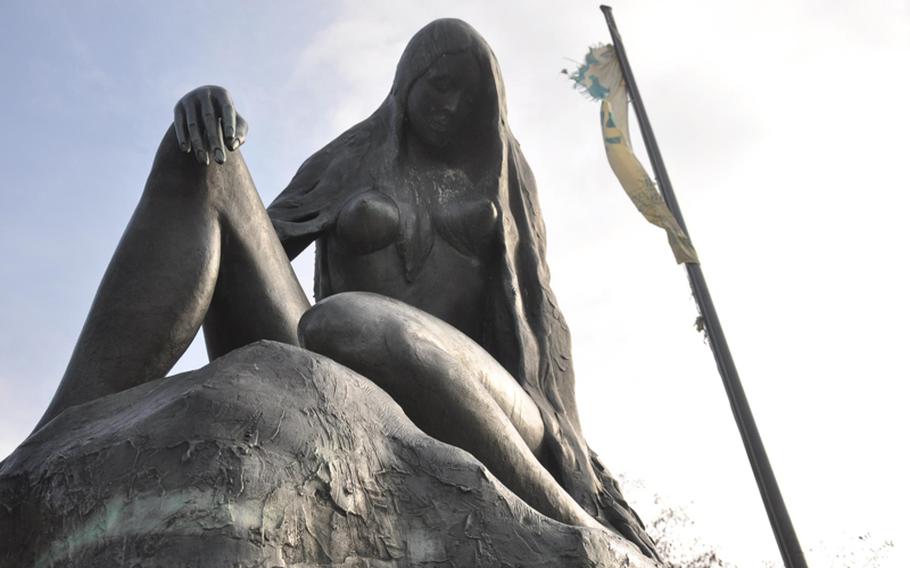
The "Lorelei" statue sits on a narrow arm of land jutting out into the Rhine River between St. Goar and St. Goarshausen, Germany, not far from Wiesbaden. The legends -- and the river views -- that accompany the statue are worth discovering. (Dan Blottenberger/Stars and Stripes)
The tales of a woman named Lorelei in Germany’s Rhine River Valley date back several centuries. According to legend, many boats lie at the bottom of the Rhine River because of her.
As the legend goes, in the narrowest and deepest point of the Rhine there once was a woman of such beauty that she would cause sailors to wreck their ships as they sailed the dangerous currents along the river’s jagged shorelines.
Was it her long, blonde hair? Were sailors distracted because she lay sunbathing along the river’s edge? Or was Lorelei a siren who intentionally lured bewitched sailors to their doom by singing the loveliest song they had ever heard? Each version of the legend has earned a place in Rhine Valley lore.
A woman beautiful enough to cause shipwrecks? That was worth checking out. The only problem was, I got there several centuries too late, and now all that is left of the legend herself is a statue sitting at the end of a narrow arm of land that juts out into the Rhine.
The mysticism of the area is apparent. Located less than 16 miles from the popular tourist town of Rüdesheim and less than 40 miles from Wiesbaden, the “Lorelei” statue basks in environmental beauty, surrounded by sweeping, hillside vineyards and seated in a picture-perfect location that offers views of St. Goar, St. Goarshausen and the gracefully winding river. The statue stands about 16 feet high, according to the St. Goarshausen Tourist Office, so it has a very regal overview of the river and its surroundings.
On my journey to “Lorelei,” I went by car, although tour boats cruise past the statue regularly. In St. Goar, I discovered I was on the wrong side of the river if I wanted to walk out to the statue, so I took a two-minute ferry ride to the opposite side of the river and St. Goarshausen.
Once back on solid ground, I asked a local couple for directions to the statue and they pointed me in the right direction. There is no boat that takes visitors right up to the statue, so if you want a close-up view of the “Lorelei,” you have to walk to her.
I went to “Lorelei” in late February and as I made my way down the main street of St. Goarshausen, I found that I had come on the day of the town’s annual Fasching parade. With celebratory music accompanying my trip and passing a number of people dressed in costumes, I made my way along the Rhine.
Past the St. Goarshausen city limits, traveler’s anxiety began to kick in, but as I passed a bus stop covered with graffiti, I glanced out into the river and there she was.
I continued to walk until I reached a point where the St. Goarshausen side met with the arm of land on which the statue rests. What the local couple failed to tell me was that it is a little more than half a mile from St. Goarshausen to where the arm of land juts out into the river and then another half a mile until you reach the statue.
The pedestrian path to the statue is jagged rock (not recommended for small children). On the footpath there are boat anchors and stairs leading to small beaches. It takes about 30 minutes to get to the statue from the start of the footpath. But the view is well worth the walk. From “Lorelei’s” perch, you can see the small riverside towns of St. Goar and St. Goarshausen, along with their castles, as well as a wide sweep of the Rhine River.
On the QT DIRECTIONS
From Wiesbaden, the trip is about 40 miles. By car, get on highway A60 toward Trier/Koblenz/Bingen. Stay on the highway for about 13 miles and take a right onto highway E42, then merge right onto highway A61, where you will take exit 49 for Bingen-Mitte toward B9/St.Goar/Rhein. Once you exit the highway, follow the road along the Rhine River for about 19 miles, passing through several towns until you see signs for St. Goar or “Lorelei Blick.” If you take E42 to St. Goarshausen you will need to take a ferry (which can be done with or without a car) to the St. Goar side of the river, where you can then walk to the “Lorelei” statue’s viewing point.
COSTS
The ferry costs 1.50 euros one way for pedestrians or 3.50 euros for vehicles. Family packages are available. Access to the statue, which is free, is available 24 hours, but, for safety reasons, it’s best to go only during daylight.
ACCOMMODATIONS
There are several small hotels in towns all along the Rhine River. Cafes, restaurants and beer gardens abound. There are also several kiosks to grab a quick meal at most of the ferry points.
INFORMATION
Free parking is available at the so-called Lorelei rock.Tourist office phone: 06771–9100. English is spoken. Email: info@loreley-touristik.de